Applying Motivation Theories in Modern People Management Systems
VerifiedAdded on 2023/06/18
|8
|2201
|170
Essay
AI Summary
This essay explores the concept of motivation and its significance in managing people and systems within organizations. It delves into various motivation theories, including Maslow's hierarchy of needs, Alderfer's ERG theory, McClelland's theory, and Herzberg's dual-factor theory, with a particular focus on Maslow's theory and its application in modern workplaces. The essay discusses how understanding and applying these theories can help managers create a motivating environment, boost employee morale, and enhance overall organizational productivity by satisfying employee needs and fostering better communication and relationships. The evolution of the modern workplace, driven by technological advancements and changing employee expectations, is also examined, emphasizing the importance of adapting management strategies to meet the needs of today's workforce.
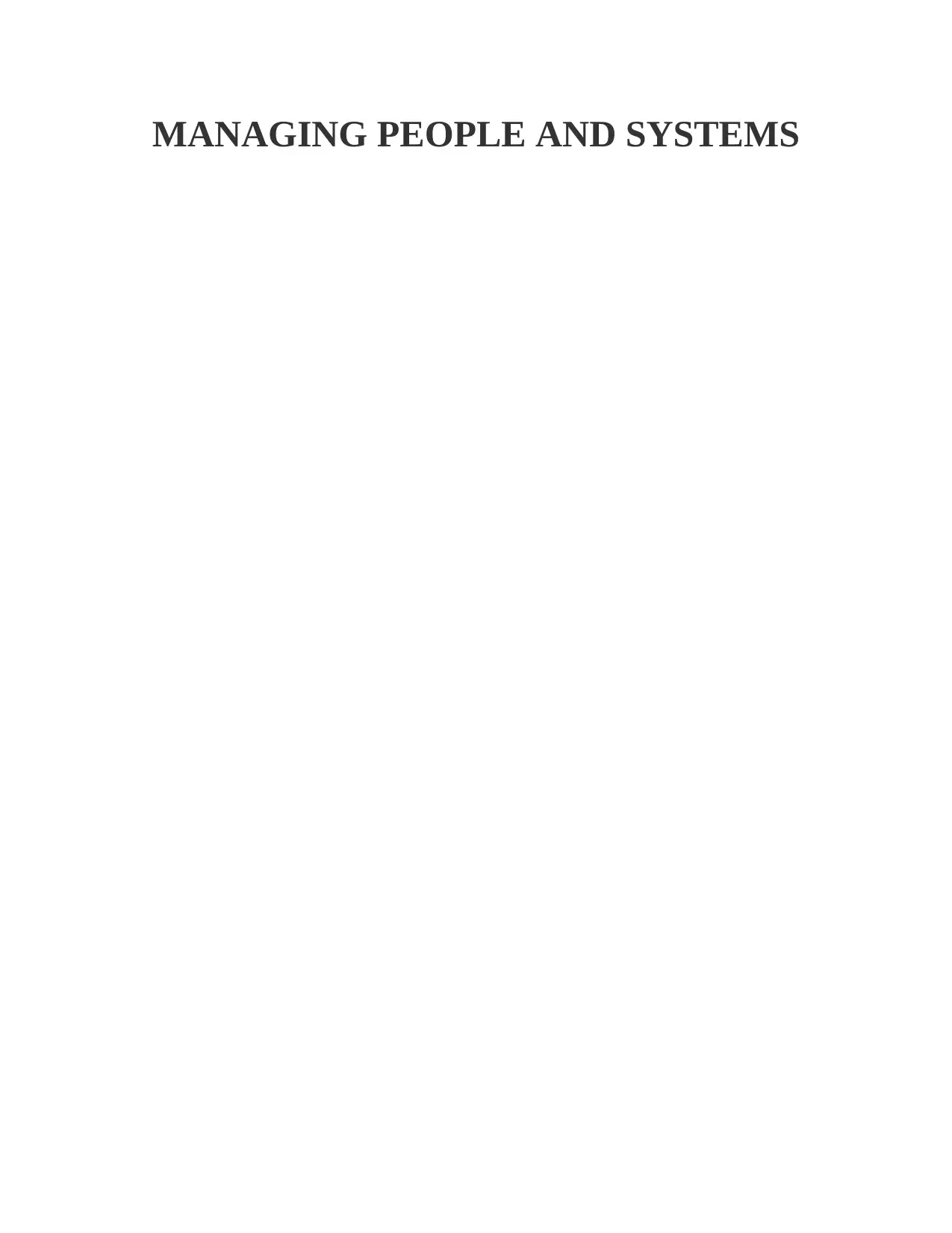
MANAGING PEOPLE AND SYSTEMS
Paraphrase This Document
Need a fresh take? Get an instant paraphrase of this document with our AI Paraphraser
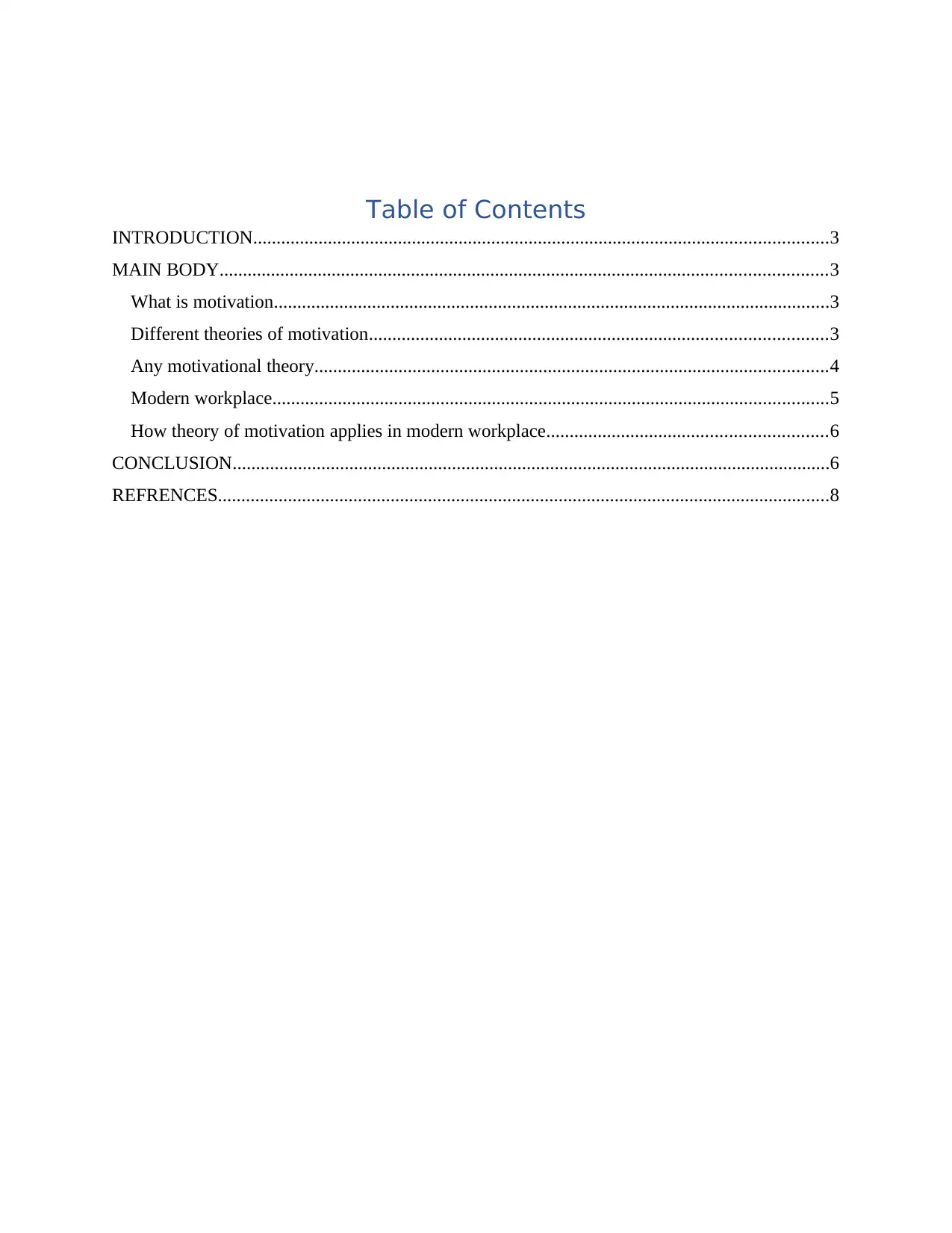
Table of Contents
INTRODUCTION...........................................................................................................................3
MAIN BODY..................................................................................................................................3
What is motivation.......................................................................................................................3
Different theories of motivation..................................................................................................3
Any motivational theory..............................................................................................................4
Modern workplace.......................................................................................................................5
How theory of motivation applies in modern workplace............................................................6
CONCLUSION................................................................................................................................6
REFRENCES...................................................................................................................................8
INTRODUCTION...........................................................................................................................3
MAIN BODY..................................................................................................................................3
What is motivation.......................................................................................................................3
Different theories of motivation..................................................................................................3
Any motivational theory..............................................................................................................4
Modern workplace.......................................................................................................................5
How theory of motivation applies in modern workplace............................................................6
CONCLUSION................................................................................................................................6
REFRENCES...................................................................................................................................8
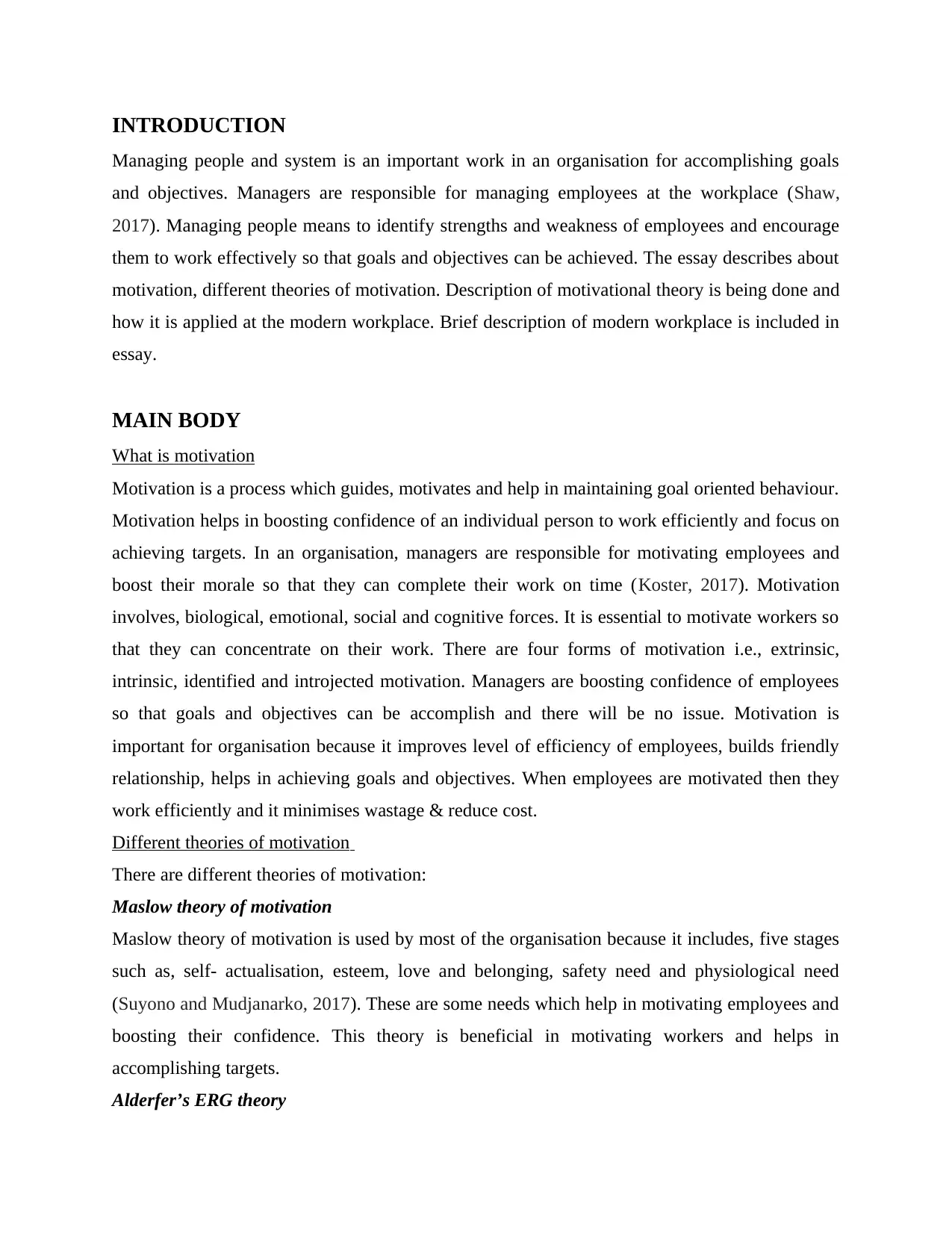
INTRODUCTION
Managing people and system is an important work in an organisation for accomplishing goals
and objectives. Managers are responsible for managing employees at the workplace (Shaw,
2017). Managing people means to identify strengths and weakness of employees and encourage
them to work effectively so that goals and objectives can be achieved. The essay describes about
motivation, different theories of motivation. Description of motivational theory is being done and
how it is applied at the modern workplace. Brief description of modern workplace is included in
essay.
MAIN BODY
What is motivation
Motivation is a process which guides, motivates and help in maintaining goal oriented behaviour.
Motivation helps in boosting confidence of an individual person to work efficiently and focus on
achieving targets. In an organisation, managers are responsible for motivating employees and
boost their morale so that they can complete their work on time (Koster, 2017). Motivation
involves, biological, emotional, social and cognitive forces. It is essential to motivate workers so
that they can concentrate on their work. There are four forms of motivation i.e., extrinsic,
intrinsic, identified and introjected motivation. Managers are boosting confidence of employees
so that goals and objectives can be accomplish and there will be no issue. Motivation is
important for organisation because it improves level of efficiency of employees, builds friendly
relationship, helps in achieving goals and objectives. When employees are motivated then they
work efficiently and it minimises wastage & reduce cost.
Different theories of motivation
There are different theories of motivation:
Maslow theory of motivation
Maslow theory of motivation is used by most of the organisation because it includes, five stages
such as, self- actualisation, esteem, love and belonging, safety need and physiological need
(Suyono and Mudjanarko, 2017). These are some needs which help in motivating employees and
boosting their confidence. This theory is beneficial in motivating workers and helps in
accomplishing targets.
Alderfer’s ERG theory
Managing people and system is an important work in an organisation for accomplishing goals
and objectives. Managers are responsible for managing employees at the workplace (Shaw,
2017). Managing people means to identify strengths and weakness of employees and encourage
them to work effectively so that goals and objectives can be achieved. The essay describes about
motivation, different theories of motivation. Description of motivational theory is being done and
how it is applied at the modern workplace. Brief description of modern workplace is included in
essay.
MAIN BODY
What is motivation
Motivation is a process which guides, motivates and help in maintaining goal oriented behaviour.
Motivation helps in boosting confidence of an individual person to work efficiently and focus on
achieving targets. In an organisation, managers are responsible for motivating employees and
boost their morale so that they can complete their work on time (Koster, 2017). Motivation
involves, biological, emotional, social and cognitive forces. It is essential to motivate workers so
that they can concentrate on their work. There are four forms of motivation i.e., extrinsic,
intrinsic, identified and introjected motivation. Managers are boosting confidence of employees
so that goals and objectives can be accomplish and there will be no issue. Motivation is
important for organisation because it improves level of efficiency of employees, builds friendly
relationship, helps in achieving goals and objectives. When employees are motivated then they
work efficiently and it minimises wastage & reduce cost.
Different theories of motivation
There are different theories of motivation:
Maslow theory of motivation
Maslow theory of motivation is used by most of the organisation because it includes, five stages
such as, self- actualisation, esteem, love and belonging, safety need and physiological need
(Suyono and Mudjanarko, 2017). These are some needs which help in motivating employees and
boosting their confidence. This theory is beneficial in motivating workers and helps in
accomplishing targets.
Alderfer’s ERG theory
⊘ This is a preview!⊘
Do you want full access?
Subscribe today to unlock all pages.

Trusted by 1+ million students worldwide
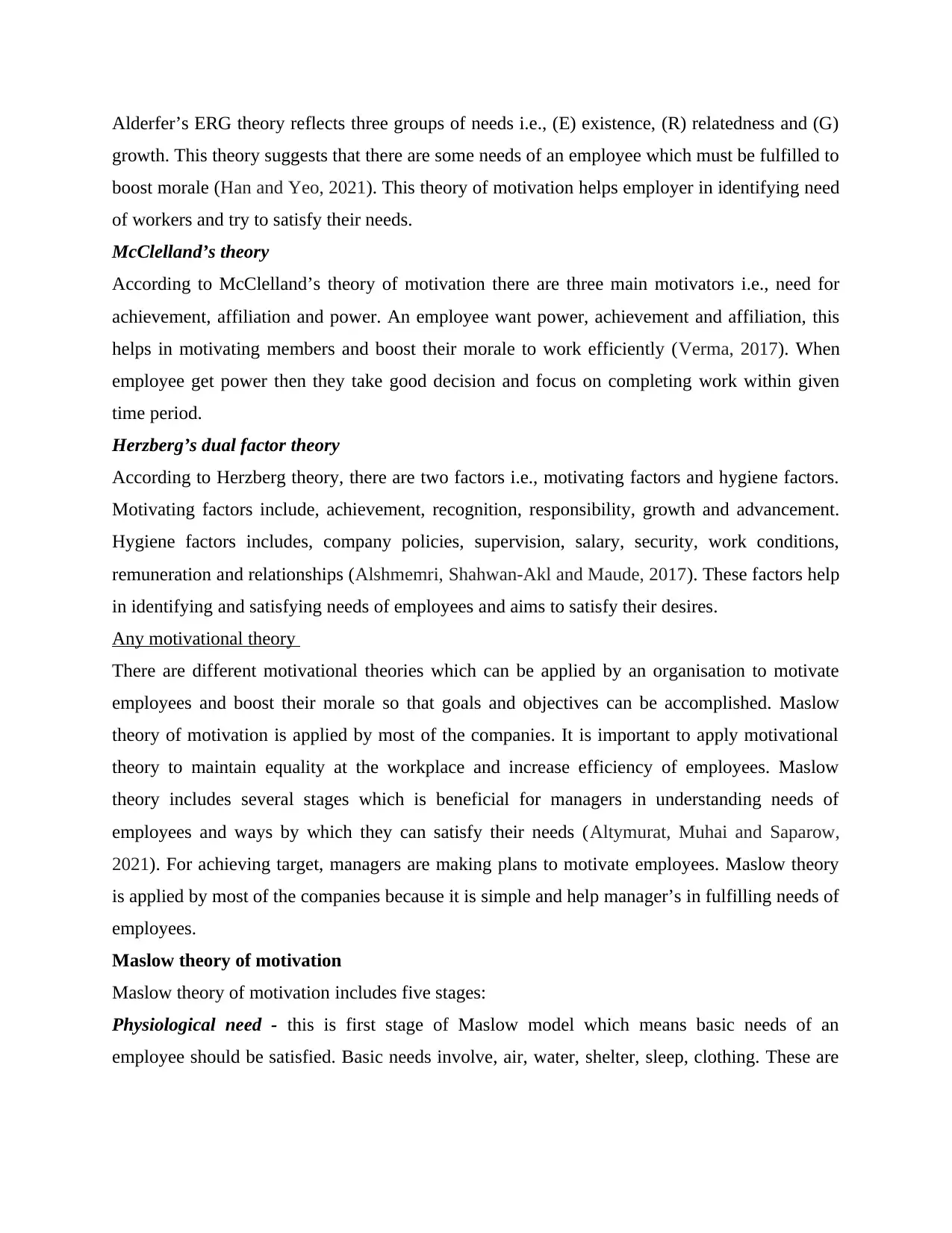
Alderfer’s ERG theory reflects three groups of needs i.e., (E) existence, (R) relatedness and (G)
growth. This theory suggests that there are some needs of an employee which must be fulfilled to
boost morale (Han and Yeo, 2021). This theory of motivation helps employer in identifying need
of workers and try to satisfy their needs.
McClelland’s theory
According to McClelland’s theory of motivation there are three main motivators i.e., need for
achievement, affiliation and power. An employee want power, achievement and affiliation, this
helps in motivating members and boost their morale to work efficiently (Verma, 2017). When
employee get power then they take good decision and focus on completing work within given
time period.
Herzberg’s dual factor theory
According to Herzberg theory, there are two factors i.e., motivating factors and hygiene factors.
Motivating factors include, achievement, recognition, responsibility, growth and advancement.
Hygiene factors includes, company policies, supervision, salary, security, work conditions,
remuneration and relationships (Alshmemri, Shahwan-Akl and Maude, 2017). These factors help
in identifying and satisfying needs of employees and aims to satisfy their desires.
Any motivational theory
There are different motivational theories which can be applied by an organisation to motivate
employees and boost their morale so that goals and objectives can be accomplished. Maslow
theory of motivation is applied by most of the companies. It is important to apply motivational
theory to maintain equality at the workplace and increase efficiency of employees. Maslow
theory includes several stages which is beneficial for managers in understanding needs of
employees and ways by which they can satisfy their needs (Altymurat, Muhai and Saparow,
2021). For achieving target, managers are making plans to motivate employees. Maslow theory
is applied by most of the companies because it is simple and help manager’s in fulfilling needs of
employees.
Maslow theory of motivation
Maslow theory of motivation includes five stages:
Physiological need - this is first stage of Maslow model which means basic needs of an
employee should be satisfied. Basic needs involve, air, water, shelter, sleep, clothing. These are
growth. This theory suggests that there are some needs of an employee which must be fulfilled to
boost morale (Han and Yeo, 2021). This theory of motivation helps employer in identifying need
of workers and try to satisfy their needs.
McClelland’s theory
According to McClelland’s theory of motivation there are three main motivators i.e., need for
achievement, affiliation and power. An employee want power, achievement and affiliation, this
helps in motivating members and boost their morale to work efficiently (Verma, 2017). When
employee get power then they take good decision and focus on completing work within given
time period.
Herzberg’s dual factor theory
According to Herzberg theory, there are two factors i.e., motivating factors and hygiene factors.
Motivating factors include, achievement, recognition, responsibility, growth and advancement.
Hygiene factors includes, company policies, supervision, salary, security, work conditions,
remuneration and relationships (Alshmemri, Shahwan-Akl and Maude, 2017). These factors help
in identifying and satisfying needs of employees and aims to satisfy their desires.
Any motivational theory
There are different motivational theories which can be applied by an organisation to motivate
employees and boost their morale so that goals and objectives can be accomplished. Maslow
theory of motivation is applied by most of the companies. It is important to apply motivational
theory to maintain equality at the workplace and increase efficiency of employees. Maslow
theory includes several stages which is beneficial for managers in understanding needs of
employees and ways by which they can satisfy their needs (Altymurat, Muhai and Saparow,
2021). For achieving target, managers are making plans to motivate employees. Maslow theory
is applied by most of the companies because it is simple and help manager’s in fulfilling needs of
employees.
Maslow theory of motivation
Maslow theory of motivation includes five stages:
Physiological need - this is first stage of Maslow model which means basic needs of an
employee should be satisfied. Basic needs involve, air, water, shelter, sleep, clothing. These are
Paraphrase This Document
Need a fresh take? Get an instant paraphrase of this document with our AI Paraphraser
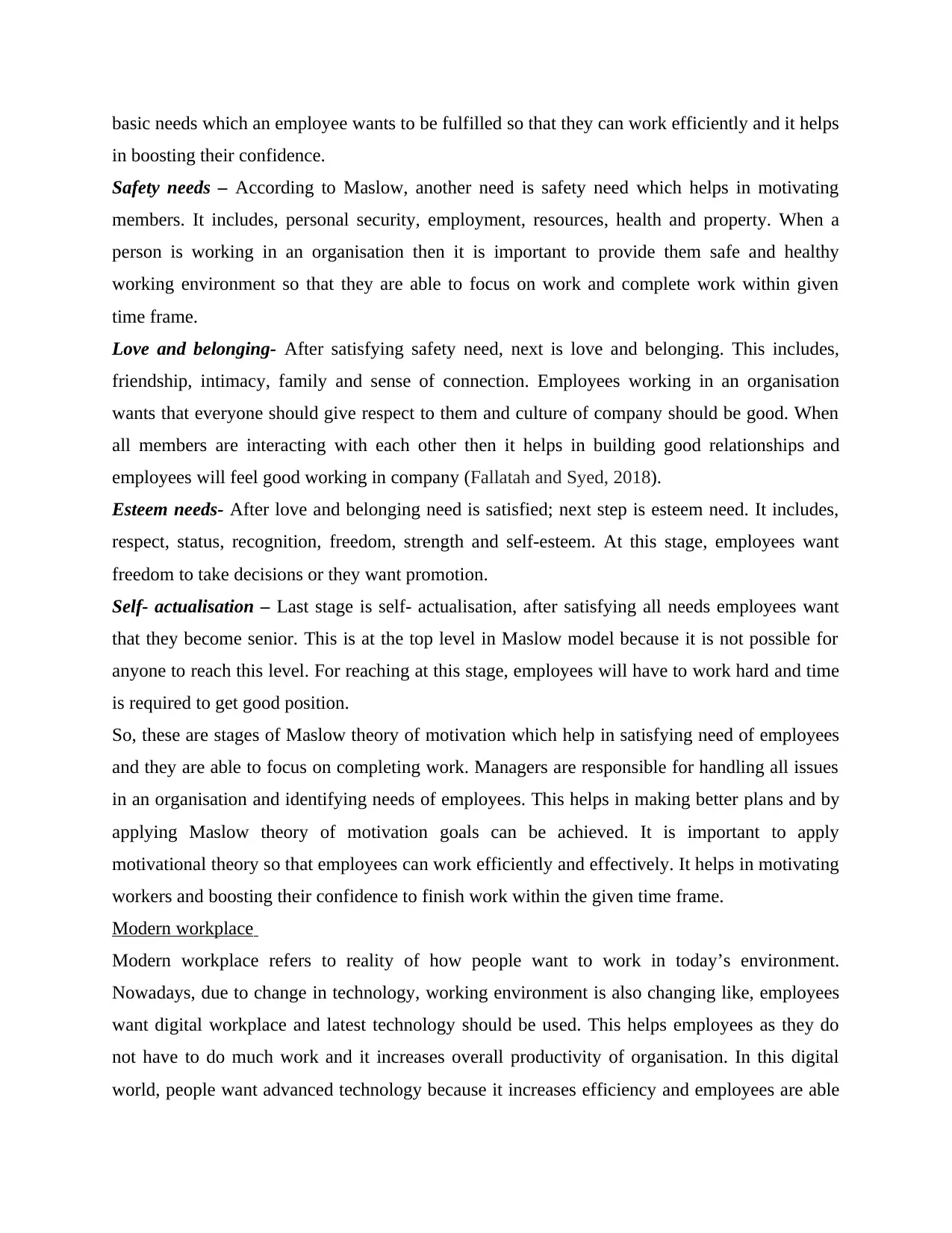
basic needs which an employee wants to be fulfilled so that they can work efficiently and it helps
in boosting their confidence.
Safety needs – According to Maslow, another need is safety need which helps in motivating
members. It includes, personal security, employment, resources, health and property. When a
person is working in an organisation then it is important to provide them safe and healthy
working environment so that they are able to focus on work and complete work within given
time frame.
Love and belonging- After satisfying safety need, next is love and belonging. This includes,
friendship, intimacy, family and sense of connection. Employees working in an organisation
wants that everyone should give respect to them and culture of company should be good. When
all members are interacting with each other then it helps in building good relationships and
employees will feel good working in company (Fallatah and Syed, 2018).
Esteem needs- After love and belonging need is satisfied; next step is esteem need. It includes,
respect, status, recognition, freedom, strength and self-esteem. At this stage, employees want
freedom to take decisions or they want promotion.
Self- actualisation – Last stage is self- actualisation, after satisfying all needs employees want
that they become senior. This is at the top level in Maslow model because it is not possible for
anyone to reach this level. For reaching at this stage, employees will have to work hard and time
is required to get good position.
So, these are stages of Maslow theory of motivation which help in satisfying need of employees
and they are able to focus on completing work. Managers are responsible for handling all issues
in an organisation and identifying needs of employees. This helps in making better plans and by
applying Maslow theory of motivation goals can be achieved. It is important to apply
motivational theory so that employees can work efficiently and effectively. It helps in motivating
workers and boosting their confidence to finish work within the given time frame.
Modern workplace
Modern workplace refers to reality of how people want to work in today’s environment.
Nowadays, due to change in technology, working environment is also changing like, employees
want digital workplace and latest technology should be used. This helps employees as they do
not have to do much work and it increases overall productivity of organisation. In this digital
world, people want advanced technology because it increases efficiency and employees are able
in boosting their confidence.
Safety needs – According to Maslow, another need is safety need which helps in motivating
members. It includes, personal security, employment, resources, health and property. When a
person is working in an organisation then it is important to provide them safe and healthy
working environment so that they are able to focus on work and complete work within given
time frame.
Love and belonging- After satisfying safety need, next is love and belonging. This includes,
friendship, intimacy, family and sense of connection. Employees working in an organisation
wants that everyone should give respect to them and culture of company should be good. When
all members are interacting with each other then it helps in building good relationships and
employees will feel good working in company (Fallatah and Syed, 2018).
Esteem needs- After love and belonging need is satisfied; next step is esteem need. It includes,
respect, status, recognition, freedom, strength and self-esteem. At this stage, employees want
freedom to take decisions or they want promotion.
Self- actualisation – Last stage is self- actualisation, after satisfying all needs employees want
that they become senior. This is at the top level in Maslow model because it is not possible for
anyone to reach this level. For reaching at this stage, employees will have to work hard and time
is required to get good position.
So, these are stages of Maslow theory of motivation which help in satisfying need of employees
and they are able to focus on completing work. Managers are responsible for handling all issues
in an organisation and identifying needs of employees. This helps in making better plans and by
applying Maslow theory of motivation goals can be achieved. It is important to apply
motivational theory so that employees can work efficiently and effectively. It helps in motivating
workers and boosting their confidence to finish work within the given time frame.
Modern workplace
Modern workplace refers to reality of how people want to work in today’s environment.
Nowadays, due to change in technology, working environment is also changing like, employees
want digital workplace and latest technology should be used. This helps employees as they do
not have to do much work and it increases overall productivity of organisation. In this digital
world, people want advanced technology because it increases efficiency and employees are able
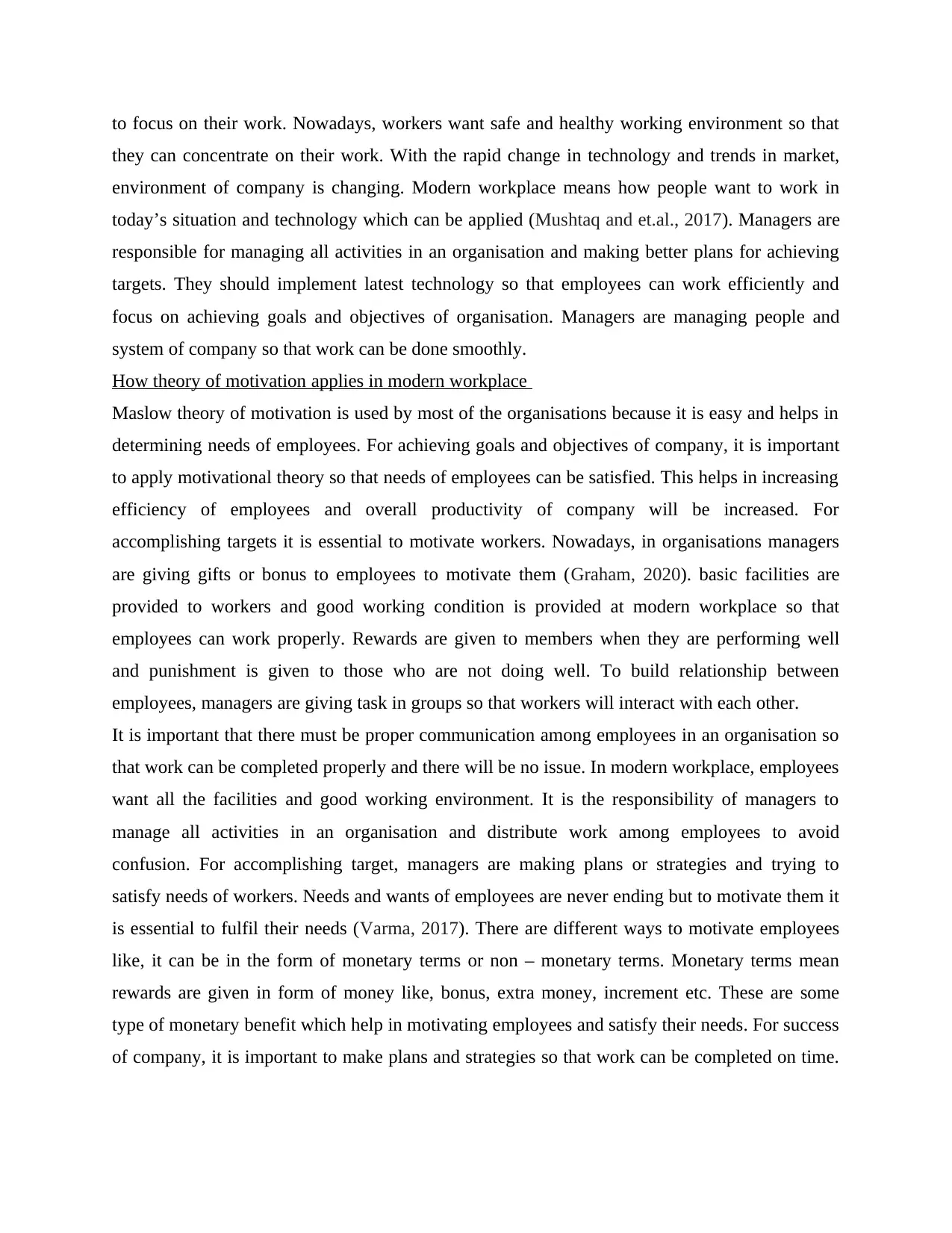
to focus on their work. Nowadays, workers want safe and healthy working environment so that
they can concentrate on their work. With the rapid change in technology and trends in market,
environment of company is changing. Modern workplace means how people want to work in
today’s situation and technology which can be applied (Mushtaq and et.al., 2017). Managers are
responsible for managing all activities in an organisation and making better plans for achieving
targets. They should implement latest technology so that employees can work efficiently and
focus on achieving goals and objectives of organisation. Managers are managing people and
system of company so that work can be done smoothly.
How theory of motivation applies in modern workplace
Maslow theory of motivation is used by most of the organisations because it is easy and helps in
determining needs of employees. For achieving goals and objectives of company, it is important
to apply motivational theory so that needs of employees can be satisfied. This helps in increasing
efficiency of employees and overall productivity of company will be increased. For
accomplishing targets it is essential to motivate workers. Nowadays, in organisations managers
are giving gifts or bonus to employees to motivate them (Graham, 2020). basic facilities are
provided to workers and good working condition is provided at modern workplace so that
employees can work properly. Rewards are given to members when they are performing well
and punishment is given to those who are not doing well. To build relationship between
employees, managers are giving task in groups so that workers will interact with each other.
It is important that there must be proper communication among employees in an organisation so
that work can be completed properly and there will be no issue. In modern workplace, employees
want all the facilities and good working environment. It is the responsibility of managers to
manage all activities in an organisation and distribute work among employees to avoid
confusion. For accomplishing target, managers are making plans or strategies and trying to
satisfy needs of workers. Needs and wants of employees are never ending but to motivate them it
is essential to fulfil their needs (Varma, 2017). There are different ways to motivate employees
like, it can be in the form of monetary terms or non – monetary terms. Monetary terms mean
rewards are given in form of money like, bonus, extra money, increment etc. These are some
type of monetary benefit which help in motivating employees and satisfy their needs. For success
of company, it is important to make plans and strategies so that work can be completed on time.
they can concentrate on their work. With the rapid change in technology and trends in market,
environment of company is changing. Modern workplace means how people want to work in
today’s situation and technology which can be applied (Mushtaq and et.al., 2017). Managers are
responsible for managing all activities in an organisation and making better plans for achieving
targets. They should implement latest technology so that employees can work efficiently and
focus on achieving goals and objectives of organisation. Managers are managing people and
system of company so that work can be done smoothly.
How theory of motivation applies in modern workplace
Maslow theory of motivation is used by most of the organisations because it is easy and helps in
determining needs of employees. For achieving goals and objectives of company, it is important
to apply motivational theory so that needs of employees can be satisfied. This helps in increasing
efficiency of employees and overall productivity of company will be increased. For
accomplishing targets it is essential to motivate workers. Nowadays, in organisations managers
are giving gifts or bonus to employees to motivate them (Graham, 2020). basic facilities are
provided to workers and good working condition is provided at modern workplace so that
employees can work properly. Rewards are given to members when they are performing well
and punishment is given to those who are not doing well. To build relationship between
employees, managers are giving task in groups so that workers will interact with each other.
It is important that there must be proper communication among employees in an organisation so
that work can be completed properly and there will be no issue. In modern workplace, employees
want all the facilities and good working environment. It is the responsibility of managers to
manage all activities in an organisation and distribute work among employees to avoid
confusion. For accomplishing target, managers are making plans or strategies and trying to
satisfy needs of workers. Needs and wants of employees are never ending but to motivate them it
is essential to fulfil their needs (Varma, 2017). There are different ways to motivate employees
like, it can be in the form of monetary terms or non – monetary terms. Monetary terms mean
rewards are given in form of money like, bonus, extra money, increment etc. These are some
type of monetary benefit which help in motivating employees and satisfy their needs. For success
of company, it is important to make plans and strategies so that work can be completed on time.
⊘ This is a preview!⊘
Do you want full access?
Subscribe today to unlock all pages.

Trusted by 1+ million students worldwide
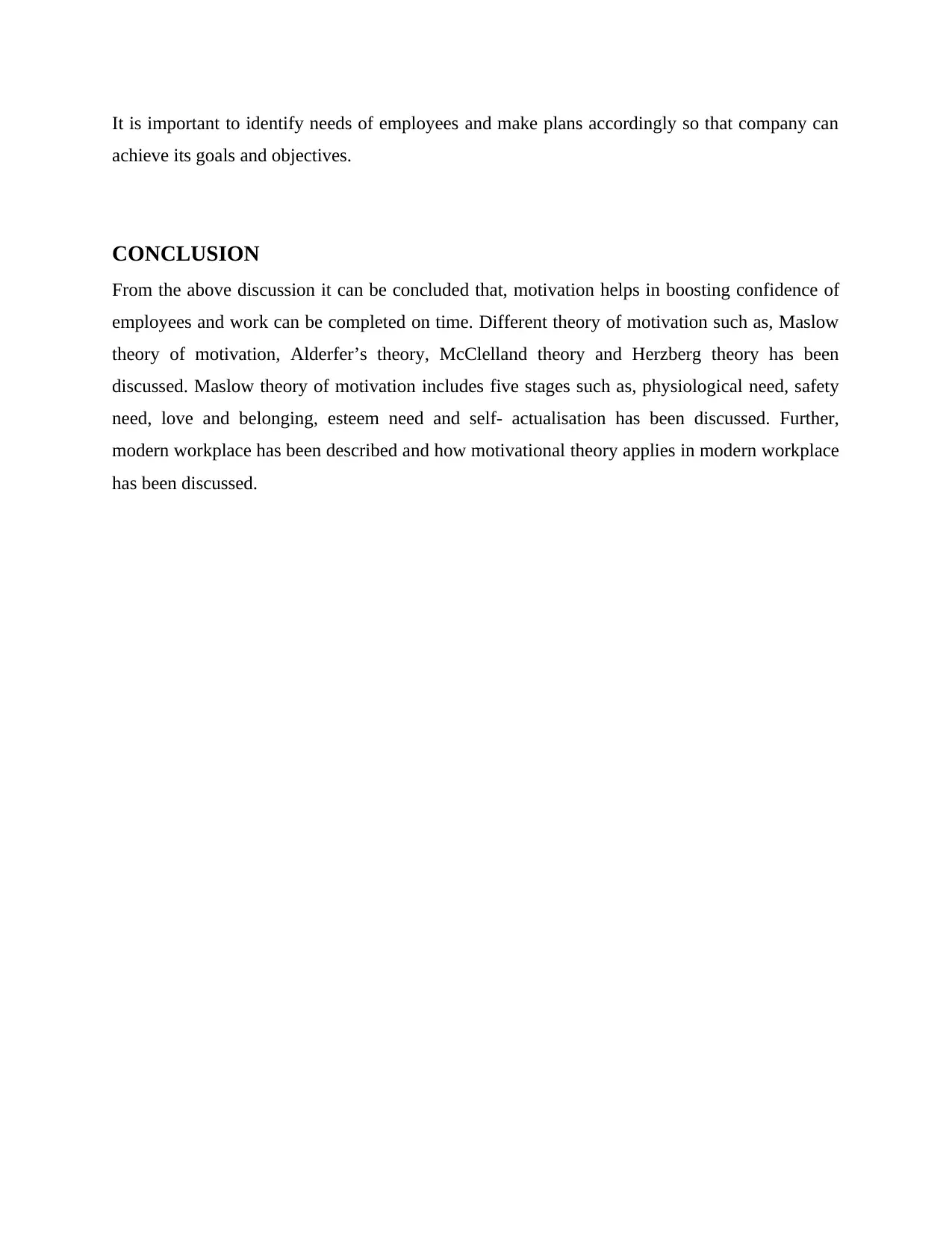
It is important to identify needs of employees and make plans accordingly so that company can
achieve its goals and objectives.
CONCLUSION
From the above discussion it can be concluded that, motivation helps in boosting confidence of
employees and work can be completed on time. Different theory of motivation such as, Maslow
theory of motivation, Alderfer’s theory, McClelland theory and Herzberg theory has been
discussed. Maslow theory of motivation includes five stages such as, physiological need, safety
need, love and belonging, esteem need and self- actualisation has been discussed. Further,
modern workplace has been described and how motivational theory applies in modern workplace
has been discussed.
achieve its goals and objectives.
CONCLUSION
From the above discussion it can be concluded that, motivation helps in boosting confidence of
employees and work can be completed on time. Different theory of motivation such as, Maslow
theory of motivation, Alderfer’s theory, McClelland theory and Herzberg theory has been
discussed. Maslow theory of motivation includes five stages such as, physiological need, safety
need, love and belonging, esteem need and self- actualisation has been discussed. Further,
modern workplace has been described and how motivational theory applies in modern workplace
has been discussed.
Paraphrase This Document
Need a fresh take? Get an instant paraphrase of this document with our AI Paraphraser

REFRENCES
Books and Journals
Alshmemri, M., Shahwan-Akl, L. and Maude, P., 2017. Herzberg’s two-factor theory. Life
Science Journal. 14(5). pp.12-16.
Altymurat, A., Muhai, M. and Saparow, T., 2021. Human Behavior in Organizations Related to
Abraham Maslow's Hierarchy of Needs Theory. Interdisciplinary Journal Papier
Human Review. 2(1). pp.12-16.
Fallatah, R. H. M. and Syed, J., 2018. A critical review of Maslow’s hierarchy of
needs. employee motivation in Saudi Arabia, pp.19-59.
Graham, S., 2020. An attributional theory of motivation. Contemporary Educational
Psychology. 61. p.101861.
Han, Y. K. and Yeo, A. N., 2021. A Study on Dental Hygiene and Career Maturity of Students
Based on Alderfer's ERG Theory. Journal of dental hygiene science. 21(2). pp.86-95.
Koster, D., 2017. Motivation in the workplace.
Mushtaq, M., and et.al., 2017. Forging ahead: How to thrive at the modern workplace. Iranian
Journal of Management Studies. 10(4). pp.783-818.
Shaw, D., 2017. Managing people and learning in organisational change projects. Journal of
Organizational Change Management.
Suyono, J. and Mudjanarko, S., 2017. Motivation engineering to employee by employees
Abraham Maslow theory. Journal of Education, Teaching and Learning. 2(1). pp.27-33.
Varma, C., 2017. Importance of employee motivation & job satisfaction for organizational
performance. International journal of social science & interdisciplinary research. 6(2).
Verma, N., 2017. A profile based study on McClelland's needs. Journal of Management
Research. 17(2). pp.65-73.
Books and Journals
Alshmemri, M., Shahwan-Akl, L. and Maude, P., 2017. Herzberg’s two-factor theory. Life
Science Journal. 14(5). pp.12-16.
Altymurat, A., Muhai, M. and Saparow, T., 2021. Human Behavior in Organizations Related to
Abraham Maslow's Hierarchy of Needs Theory. Interdisciplinary Journal Papier
Human Review. 2(1). pp.12-16.
Fallatah, R. H. M. and Syed, J., 2018. A critical review of Maslow’s hierarchy of
needs. employee motivation in Saudi Arabia, pp.19-59.
Graham, S., 2020. An attributional theory of motivation. Contemporary Educational
Psychology. 61. p.101861.
Han, Y. K. and Yeo, A. N., 2021. A Study on Dental Hygiene and Career Maturity of Students
Based on Alderfer's ERG Theory. Journal of dental hygiene science. 21(2). pp.86-95.
Koster, D., 2017. Motivation in the workplace.
Mushtaq, M., and et.al., 2017. Forging ahead: How to thrive at the modern workplace. Iranian
Journal of Management Studies. 10(4). pp.783-818.
Shaw, D., 2017. Managing people and learning in organisational change projects. Journal of
Organizational Change Management.
Suyono, J. and Mudjanarko, S., 2017. Motivation engineering to employee by employees
Abraham Maslow theory. Journal of Education, Teaching and Learning. 2(1). pp.27-33.
Varma, C., 2017. Importance of employee motivation & job satisfaction for organizational
performance. International journal of social science & interdisciplinary research. 6(2).
Verma, N., 2017. A profile based study on McClelland's needs. Journal of Management
Research. 17(2). pp.65-73.
1 out of 8
Related Documents
Your All-in-One AI-Powered Toolkit for Academic Success.
+13062052269
info@desklib.com
Available 24*7 on WhatsApp / Email
![[object Object]](/_next/static/media/star-bottom.7253800d.svg)
Unlock your academic potential
Copyright © 2020–2025 A2Z Services. All Rights Reserved. Developed and managed by ZUCOL.


